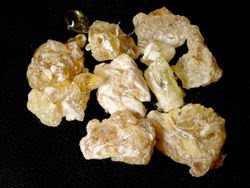 Frankincense or olibanum is well known for one good reason as it was one of the three gift to the baby Jesus brought from the Three Kings. It has been around well before this time. Frankincense was found in the tomb of the ancient Egyptian King Tutankhamen over 3300 years ago. Going back even further, frankincense has been traded on the Arabian Peninsula and in North Africa for more than 5000 years.
Frankincense or olibanum is well known for one good reason as it was one of the three gift to the baby Jesus brought from the Three Kings. It has been around well before this time. Frankincense was found in the tomb of the ancient Egyptian King Tutankhamen over 3300 years ago. Going back even further, frankincense has been traded on the Arabian Peninsula and in North Africa for more than 5000 years.But hang on, frankincense? Surely you are mistaken, this blog is called Herbsways - Ways With Herbs and is all about herbs is it not? What is frankincense doing here then?
Let me formally explain:
Herbs have many uses including culinary, medicinal and even spiritual uses. With the medicinal or spiritual use is it considered the tag 'herbs' covers all parts of the plant including leaves, roots, flowers, seeds, resin, root bark, inner bark and berries. Taking this into account, frankincense technically a herb. This will surprise many, including myself.
Basically the herb frankincense is an aromatic resin manufactured from Boswellia tree. Frankincense is used in perfumery and aromatherapy. The olibanum essential oil is obtained by steam distillation of the dry resin. It is used as an incense and in many perfumes. It is not only in the perfume industry, but is also found in cosmetics and pharmaceuticals.
The Boswellia trees have to be about 8 to 10 years old to start producing the resin. They are harvested 2 to 3 times a year. Omani frankincense is said to be the best in the world with a close second from resins produced from the north coast of Somalia. Trees are extremely hardy sometimes seemingly growing directly out of solid rock.
 The method is for frankincense to be tapped by scraping the bark, which releases resins that will bleed and harden. There are many varieties of frankincense trees, each with its own unique type of resin. Soil and climate differences give even more varieties of the resin.
The method is for frankincense to be tapped by scraping the bark, which releases resins that will bleed and harden. There are many varieties of frankincense trees, each with its own unique type of resin. Soil and climate differences give even more varieties of the resin.Christian and Islamic faiths have often used frankincense mixed with oils to anoint newborn infants and individuals considered to be moving into a new phase in their spiritual lives.
Frankincense is actually edible and often used in various traditional medicines in Asia for digestion and healthy skin. The edible frankincense must be pure for internal consumption, meaning it should be completely translucent, with no black or brown impurities. It is often light yellow with a hint of green. It is often chewed like gum, but is a bit stickier as it is a resin.
In India frankincense as medicine has been used for hundreds of years for treating arthritis. Burning frankincense repels mosquitoes and thus helps protect people and animals from mosquito-born illnesses.
 Incense preparations is effective for the treatment of Crohn's disease. The use of incense on the accompanying specimens of brain tumors and frankincense smoke as a psychoactive drug that relieves depression and anxiety in mice. Human patients that received the frankincense extract showed significant improvement in their arthritis.
Incense preparations is effective for the treatment of Crohn's disease. The use of incense on the accompanying specimens of brain tumors and frankincense smoke as a psychoactive drug that relieves depression and anxiety in mice. Human patients that received the frankincense extract showed significant improvement in their arthritis.It is a sign of greed in these parts that the trees have seen to now be in decline due to over-extraction of resin in recent years as this affect the germination of the seeds. This germination level has dropped from 80% to 16%. This will now lead to lower supplies and higher prices of course.
So, now you know more about frankincense when little Jimmy acts as one of the three Kings giving the herb, you can answer his questions on it. When I taught in Primary Schools in England, we used real frankincense and actually burned some in the classroom to give the children a 'taste' of the distinctive scent they give off. All these children will take this memory on to adulthood and never forget that moment whenever frankincense is mentioned.














